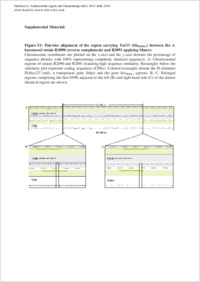Intraspecies transfer of the chromosomal Acinetobacter baumannii blaNDM-1 carbapenemase gene
- Krahn, Thomas Institute for Genome Research and Systems Biology, Center for Biotechnology (CeBiTec), Bielefeld University, Germany
- Wibberg, Daniel Institute for Genome Research and Systems Biology, Center for Biotechnology (CeBiTec), Bielefeld University, Germany
- Maus, Irena Institute for Genome Research and Systems Biology, Center for Biotechnology (CeBiTec), Bielefeld University, Germany
- Winkler, Anika Institute for Genome Research and Systems Biology, Center for Biotechnology (CeBiTec), Bielefeld University, Germany
- Bontron, Séverine Emerging Antibiotic Resistance Unit, Medical and Molecular Microbiology, Department of Medicine, University of Fribourg, Switzerland
- Sczyrba, Alexander Computational Metagenomics, Faculty of Technology, Bielefeld University, Germany
- Nordmann, Patrice Emerging Antibiotic Resistance Unit, Medical and Molecular Microbiology, Department of Medicine, University of Fribourg, Switzerland - HFR - Hôpital Cantonal, Fribourg, Switzerland
- Pühler, Alfred Institute for Genome Research and Systems Biology, Center for Biotechnology (CeBiTec), Bielefeld University, Germany
- Poirel, Laurent Emerging Antibiotic Resistance Unit, Medical and Molecular Microbiology, Department of Medicine, University of Fribourg, Switzerland
- Schlüter, Andreas Institute for Genome Research and Systems Biology, Center for Biotechnology (CeBiTec), Bielefeld University, Germany
-
05.01.2016
Published in:
- Antimicrobial Agents and Chemotherapy. - 2016, vol. 60, no. 5, p. 3032–3040
English
The species Acinetobacter baumannii is one of the most important multidrug-resistant human pathogens. To determine its virulence and antibiotic resistance determinants, the genome of the nosocomial blaNDM-1-positive A. baumannii strain R2090 originating from Egypt was completely sequenced. Genome analysis revealed that strain R2090 is highly related to the community-acquired Australian A. baumannii strain D1279779. The two strains belong to sequence type 267 (ST267). Isolate R2090 harbored the chromosomally integrated transposon Tn125 carrying the carbapenemase gene blaNDM- 1 that is not present in the D1279779 genome. To test the transferability of the metallo-β-lactamase (MBL) gene region, the clinical isolate R2090 was mated with the susceptible A. baumannii recipient CIP 70.10, and the carbapenem-resistant derivative R2091 was obtained. Genome sequencing of the R2091 derivative revealed that it had received an approximately 66-kb region comprising the transposon Tn125 embedding the blaNDM-1 gene. This region had integrated into the chromosome of the recipient strain CIP 70.10. From the four known mechanisms for horizontal gene transfer (conjugation, outer membrane vesicle- mediated transfer, transformation, and transduction), conjugation could be ruled out, since strain R2090 lacks any plasmid, and a type IV secretion system is not encoded in its chromosome. However, strain R2090 possesses three putative prophages, two of which were predicted to be complete and therefore functional. Accordingly, it was supposed that the transfer of the resistance gene region from the clinical isolate R2090 to the recipient occurred by general transduction facilitated by one of the prophages present in the R2090 genome. Hence, phage-mediated transduction has to be taken into account for the dissemination of antibiotic resistance genes within the species A. baumannii.
- Faculty
- Faculté des sciences et de médecine
- Department
- Médecine 3ème année
- Language
-
- English
- Classification
- Biological sciences
- License
- License undefined
- Identifiers
-
- RERO DOC 259493
- DOI 10.1128/AAC.00124-16
- Persistent URL
- https://folia.unifr.ch/unifr/documents/305041
Other files
Statistics
Document views: 72
File downloads:
- nor_itc.pdf: 211
- nor_itc_sm.pdf: 57

